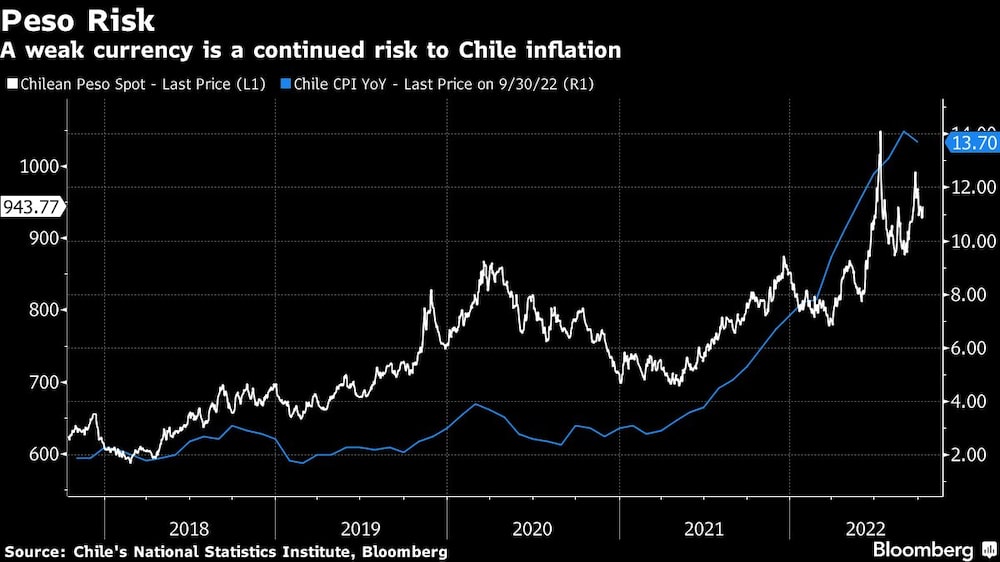Bloomberg — Chile’s central bank raised its interest rate by 50 basis points, saying borrowing costs have reached the highest level of its tightening cycle and that they will remain steady to ensure inflation eases to target.
Policymakers voted unanimously to lift borrowing costs to 11.25% late on Wednesday, as expected by most analysts in a Bloomberg survey. In a statement, board members reaffirmed their commitment “to conduct monetary policy with flexibility” to put inflation on a path to their 3% goal.
“The Board estimates that the monetary policy rate has reached its maximum level of the cycle that began in July 2021, and that it will remain there for as long as necessary to ensure the convergence of inflation to the target over the two-year policy horizon,” they wrote.
The bank led by Rosanna Costa concluded a tightening cycle that added 10.75 percentage points to borrowing costs since July 2021, after inflation eased for the first time in 19 months in September. Fuel cost increases have moderated, though economic activity has fared better than expected and the peso (CLP) has weakened. As a result, both policymakers and investors in central bank surveys see inflation remaining above target this year and next.

What Bloomberg Economics Says:
“Uncertainty about the inflation outlook remains high, but after the decision today we expect this to imply an active debate about when and by how much the central bank will start cutting rates, and not if there will be additional hikes. Signs that inflation and inflation expectations have peaked, falling domestic demand and tight monetary conditions support expectations for no more hikes.
Central bank forecasts in the September report pointed to rate cuts starting in May next year and the rate down to close to 6.75% by end-2023. We see a much more gradual adjustment.” --Felipe Hernandez, Latin America economist
The nation’s swap rates fell on Thursday, with short-end contracts down as much as 17 basis points. The Chilean peso rose 0.3% against the dollar in early trading, following gains in most emerging-market currencies.
Annual inflation slowed to 13.7% in September from a high of 14.1% the month prior, the first descent since the start of 2021, the national statistics institute reported last week. Price increases are set to moderate further, Finance Minister Mario Marcel told reporters on Oct. 6.
Central bank board members wrote that the outlook for global growth has worsened. Domestically, indicators related to private consumption show further drops, job creation is stagnant and vacancies continue to decline.
“Bank credit continues to decelerate, amid still tight supply conditions and demand that is perceived to have weakened for all segments,” policymakers wrote regarding Chile’s economy.
Coming Months
The central bank is getting help in its inflation fight from fiscal policy, as President Gabriel Boric’s administration cuts spending by about 24% this year. His government proposed a spending increase of 4.2% for 2023.
“Going forward, we expect the policy rate stable at 11.25% for the upcoming months,” Credicorp Capital economists Samuel Carrasco and Daniel Velandia wrote in a note. “The first rate cut could take place in 2Q23 to gradually converge to a level close to 7% by the end of 2023.”
Still, policymakers also noted that inflation in the past two months has been higher than estimated, mainly due to sharper rises in the some food costs. Two-year consumer price expectations remain above target, they wrote.
Indeed, there’s still plenty of reason for caution on inflation. The peso had slipped by about 5% since the previous rate-setting meeting in September, a consumer price risk that Costa flagged in remarks made on Oct. 4.
Part of the reason for the weaker peso is global financial conditions, with the US and Europe moving forward with their own aggressive monetary tightening cycles. On the other hand, Brazil paused its rate hikes last month, and traders in Latin America’s largest economy see reductions in 2023.
“We expect that the key rate will remain at this level at least until the second quarter of next year,” said Sergio Godoy, chief economist at STF Capital. “We think that the current outlook -- with a strong dollar, price indexation and a slow cool-down of the economy -- presents a challenge to the central bank.”
Read more on Bloomberg.com

